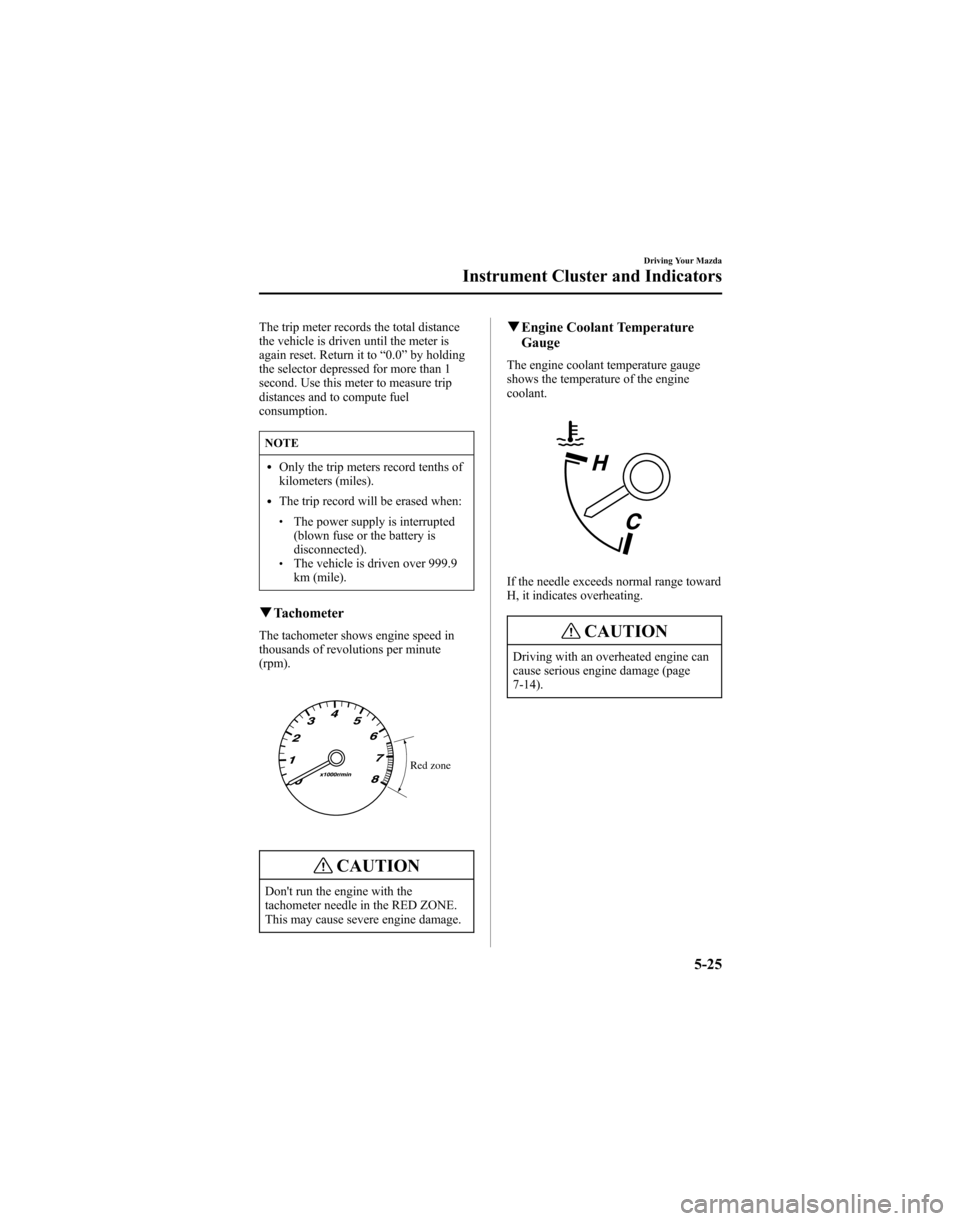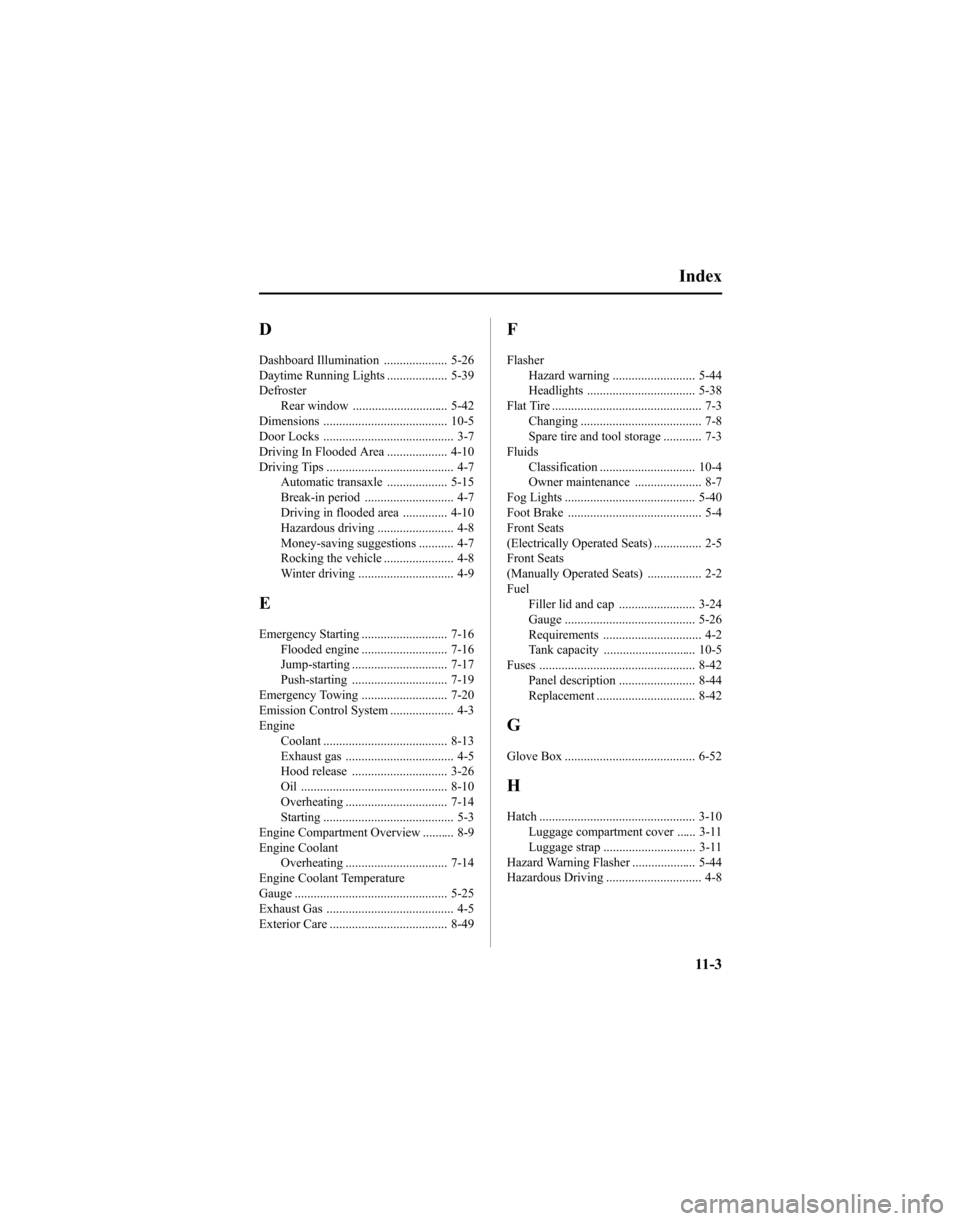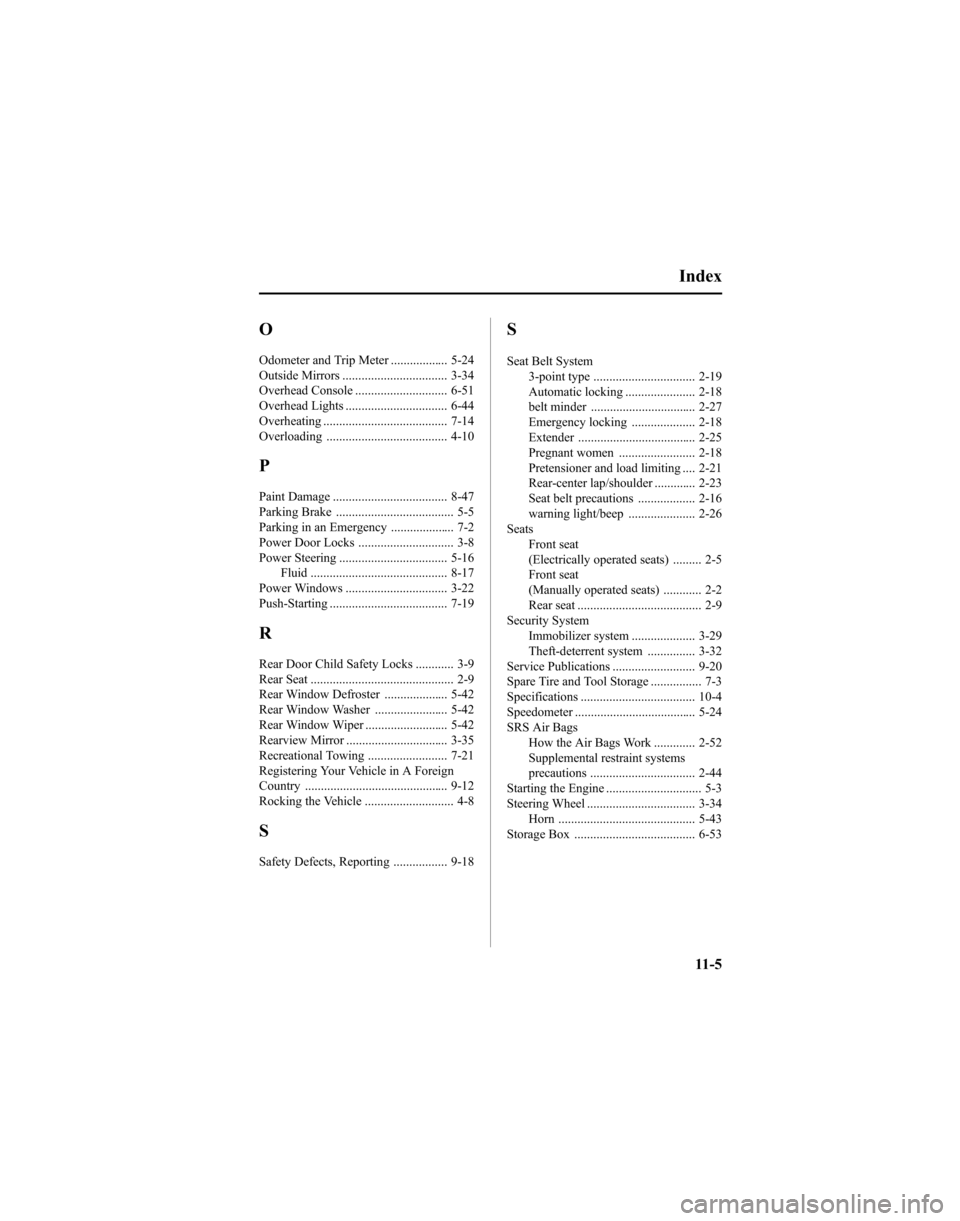engine overheat MAZDA MODEL 6 HATCHBACK 2005 Owners Manual (in English)
[x] Cancel search | Manufacturer: MAZDA, Model Year: 2005, Model line: MODEL 6 HATCHBACK, Model: MAZDA MODEL 6 HATCHBACK 2005Pages: 340, PDF Size: 3.08 MB
Page 120 of 340

Hazardous Driving
WARNING
Downshifting on Slippery Surfaces:
Downshifting into lower gear while
driving on slippery surfaces is
dangerous. The sudden change in tire
speed could cause the tires to skid.
This could lead to loss of vehicle
control and an accident. If it is
necessary to downshift on slippery
surfaces, be very careful.
When driving in water, mud, sand, or
similar hazard:
lBe cautious and allow extra distance
for braking.
lAvoid sudden braking and quick
steering.
lIf your vehicle is not equipped with
ABS, brake with the pedal by using a
light up-down motion. Don't hold the
pedal down constantly.
If your vehicle is equipped with ABS,
don't pump the brakes. Continue to
press down on the brake pedal.
lIf you get stuck, select a lower gear and
accelerate slowly. Don't spin the front
wheels.
lFor more traction in starting on
slippery surfaces, use sand, rock salt,
chains, carpeting, or other nonslip
material under the front wheels.
Rocking the Vehicle
WARNING
Spinning the Wheels:
When the vehicle is stuck, spinning
the wheels at high speed is dangerous.
The spinning tire could overheat and
explode. This could cause serious
injuries. Don't spin the wheels at more
than 56 km/h (35 mph), and don't
allow anyone to stand behind a wheel
when pushing the vehicle.
CAUTION
Too much rocking may cause engine
overheating, transaxle failure, and tire
damage.
If you must rock the vehicle to free it from
snow, sand or mud, depress the
accelerator slightly and slowly move the
shift lever from 1 (D) to R.
4-8
Before Driving Your Mazda
Driving Tips
Page 128 of 340

CAUTION
Don't try the starter for more than 10
seconds at a time. If the engine stalls or
fails to start, wait 10 seconds before
trying again. Otherwise, you may
damage the starter and drain the battery.
6. After starting the engine, let it idle for about 10 seconds.
NOTE
lIn extremely cold weather, below
–18°C (0°F), or after the vehicle has
not been driven in several days, let
the engine warm up without
operating the accelerator.
lWhether the engine is cold or warm,
it should be started without use of
the accelerator.
Brake System
q Foot Brake
Your Mazda has power-assisted brakes
that adjust automatically through normal
use.
Should power-assist fail, you can stop by
applying greater force than normal to the
brake pedal. But the distance required to
stop will be greater than usual.
WARNING
Coasting with the Engine Off:
Continuing to coast when the engine
is stalled or turned off is dangerous.
Braking will require more effort, and
the brake's power-assist could be
depleted if you pump the brake. This
will cause longer stopping distances or
even an accident. Don't continue
coasting when the engine is stalled or
turned off, find a safe place to stop.
Riding the Brakes:
Driving with your foot continuously
on the brake pedal or steadily applying
the brakes for long distances is
dangerous. This causes overheated
brakes, resulting in longer stopping
distances or even total brake failure.
This could cause loss of vehicle
control and a serious accident. Avoid
continuous application of the brakes.
Shift to a lower gear when going down
steep hills.
5-4
Driving Your Mazda
Starting and Driving
Page 139 of 340

If the vehicle is kicked down at the following speeds
or lower, the gears shift down automatically:Gear Vehicle speed
M6 →M5 212 km/h (131 mph)
M6 →M4 161 km/h (100 mph)
M5 →M4 161 km/h (100 mph)
M5 →M3 70 km/h (44 mph)
M4 →M3 70 km/h (44 mph)
M4 →M2 46 km/h (28 mph)
M3 →M2 46 km/h (28 mph)
Recommendations for shifting
Upshifting
For normal acceleration and cruising, we recommend
these shift points.
(2.3-liter engine)
Gear Vehicle speed
M1 to M2 24 km/h (15 mph)
M2 to M3 40 km/h (25 mph)
M3 to M4 65 km/h (40 mph)
(3.0-liter engine)
Gear Vehicle speed
M1 to M2 24 km/h (15 mph)
M2 to M3 40 km/h (25 mph)
M3 to M4 65 km/h (40 mph)
M4 to M5 73 km/h (45 mph)
M5 to M6 80 km/h (50 mph)
Downshifting
When you must slow down in heavy
traffic or on a steep upgrade, downshift
before the engine starts to overwork. This
gives better acceleration when you need
more speed.
On a steep downgrade , downshifting
helps maintain safe speed and prolongs
brake life.
q Driving Tips
Passing
For extra power when passing another
vehicle or climbing steep grades, depress
the accelerator fully. The transaxle will
shift to a lower gear, depending on vehicle
speed.
Climbing steep grades from a stop
To climb a steep grade from a stopped
position:
1. Depress the brake pedal.
2. Shift to D or M1, depending on the
load weight and grade steepness.
3. Release all brakes while gradually accelerating.
Descending steep grades
When descending a steep grade, shift to
lower gears, depending on load weight
and grade steepness. Descend slowly,
using the brakes only occasionally to
prevent them from overheating.
Driving Your Mazda
Starting and Driving
5-15
Page 149 of 340

The trip meter records the total distance
the vehicle is driven until the meter is
again reset. Return it to“0.0 ”by holding
the selector depressed for more than 1
second. Use this meter to measure trip
distances and to compute fuel
consumption.
NOTE
lOnly the trip meters record tenths of
kilometers (miles).
lThe trip record will be erased when:
lThe power supply is interrupted
(blown fuse or the battery is
disconnected).
lThe vehicle is driven over 999.9
km (mile).
q Tachometer
The tachometer shows engine speed in
thousands of revolutions per minute
(rpm).
Red zone
CAUTION
Don't run the engine with the
tachometer needle in the RED ZONE.
This may cause severe engine damage.
q Engine Coolant Temperature
Gauge
The engine coolant temperature gauge
shows the temperature of the engine
coolant.
If the needle exceeds normal range toward
H, it indicates overheating.
CAUTION
Driving with an overheated engine can
cause serious engine damage (page
7-14).
Driving Your Mazda
Instrument Cluster and Indicators
5-25
Page 180 of 340

WARNING
The Recirculated Air Position:
Using theposition in cold or
rainy weather will cause the windows
to fog up. Your vision will be
hampered, which could lead to a
serious accident. Do not use the
position in cold or rainy weather.
Rear window defroster switch
When using the rear window defroster
switch, refer to Rear Window Defroster
(page 5-42).
q Heating
1. Set the mode selector dial to theposition.
2. Set the air intake selector to the
position.
3. Set the temperature control dial to the hot position.
4. Set the fan control dial to the desired speed.
5. If dehumidified heating is desired, turn on the air conditioner.
NOTE
lIf the windshield fogs up easily, set
the mode selector dial to the
position.
lIf cooler air is desired at face level,
set the mode selector dial at the
position and adjust the temperature
control dial to maintain maximum
comfort.
lThe air to the floor is warmer than
air to the face (except when the
temperature control dial is set at the
extreme hot or cold position).
qCooling (With Air Conditioner)
1. Set the mode selector dial to theposition.
2. Set the temperature control dial to the cold position.
3. Set the fan control dial to the desired speed.
4. Turn on the air conditioner.
5. Adjust the fan control dial and temperature control dial to maintain
maximum comfort.
CAUTION
When using the air conditioner while
driving up long hills or in heavy traffic,
closely monitor the temperature gauge
(page 5-25).
The air conditioner may cause engine
overheating. If the gauge indicates
overheating, turn the air conditioner off.
6-8
Interior Comfort
Climate Control System
Page 229 of 340

7In Case of an Emergency
Helpful information on what to do in an emergency.
Parking in an Emergency ............................................................. 7-2Parking in an Emergency .......................................................... 7-2
Flat Tire ......................................................................................... 7-3 Spare Tire and Tool Storage ...................................................... 7-3
Changing a Flat Tire ................................................................. 7-8
Overheating ................................................................................. 7-14 Overheating ............................................................................. 7-14
Emergency Starting .................................................................... 7-16 Starting a Flooded Engine ....................................................... 7-16
Jump-Starting .......................................................................... 7-17
Push-Starting ........................................................................... 7-19
Emergency Towing ..................................................................... 7-20 Towing Description ................................................................. 7-20
Recreational Towing ............................................................... 7-21
7-1
Page 242 of 340

Overheating
If the temperature gauge indicates
overheating, the vehicle loses power, or
you hear a loud knocking or pinging
noise, the engine is probably too hot.
WARNING
Cooling Fan and EngineInspection:
Inspecting the engine with the ignition
switch in the ON position is
dangerous. The cooling fan could turn
on unexpectedly even when the engine
isn't running. You could be seriously
injured by the fan. Turn the ignition
switch off and remove the key from the
ignition switch when you inspect the
engine.
Cooling System Caps:
When the engine and radiator are hot,
scalding coolant and steam may shoot
out under pressure and cause serious
injury. Don't remove either cooling
system cap when the engine and
radiator are hot.
Steam from Overheated Engine:
Steam from an overheated engine is
dangerous. The escaping steam could
seriously burn you. Open the hood
ONLY after steam is no longer
escaping from the engine. If the temperature gauge indicates
overheating:
1. Drive safely to the side of the road and
park off the right-of-way.
2. Put a vehicle with an automatic transaxle in park (P), a manual
transaxle in neutral.
Apply the parking brake.
3. Turn off the air conditioner.
4. Check whether coolant or steam is escaping from under the hood or from
the engine compartment.
If steam is coming from the enginecompartment:
Don't go near the front of the vehicle.
Stop the engine.
Wait until the steam dissipates, then
open the hood and start the engine.
If neither coolant nor steam isescaping:
Open the hood and idle the engine until
it cools.
CAUTION
If the cooling fan does not operate
while the engine is running, the engine
temperature will increase. Stop the
engine and call an Authorized Mazda
Dealer.
5. Make sure the cooling fan is operating, then turn off the engine after the
temperature has decreased.
6. When cool, check the coolant level. If it's low, look for coolant leaks from
the radiator and hoses.
7-14
In Case of an Emergency
Overheating
Page 243 of 340

If you find a leak or other damage, or ifcoolant is still leaking:
Stop the engine and call an Authorized
Mazda Dealer.
2.3-liter engineCooling system cap
Coolant reservoir
Cooling
system cap
Coolant reservoir 3.0-liter engine
If you find no problems, the engine iscool, and no leaks are obvious:
Carefully add coolant as required (page
8-13).
CAUTION
If the engine continues to overheat or
frequently overheats, have the cooling
system inspected. The engine could be
seriously damaged unless repairs are
made. Consult an Authorized Mazda
Dealer.
In Case of an Emergency
Overheating
7-15
Page 335 of 340

D
Dashboard Illumination .................... 5-26
Daytime Running Lights ................... 5-39
DefrosterRear window .............................. 5-42
Dimensions ....................................... 10-5
Door Locks ......................................... 3-7
Driving In Flooded Area ................... 4-10
Driving Tips ........................................ 4-7 Automatic transaxle ................... 5-15
Break-in period ............................ 4-7
Driving in flooded area .............. 4-10
Hazardous driving ........................ 4-8
Money-saving suggestions ........... 4-7
Rocking the vehicle ...................... 4-8
Winter driving .............................. 4-9
E
Emergency Starting ........................... 7-16Flooded engine ........................... 7-16
Jump-starting .............................. 7-17
Push-starting .............................. 7-19
Emergency Towing ........................... 7-20
Emission Control System .................... 4-3
Engine Coolant ....................................... 8-13
Exhaust gas .................................. 4-5
Hood release .............................. 3-26
Oil .............................................. 8-10
Overheating ................................ 7-14
Starting ......................................... 5-3
Engine Compartment Overview .......... 8-9
Engine Coolant Overheating ................................ 7-14
Engine Coolant Temperature
Gauge ................................................ 5-25
Exhaust Gas ........................................ 4-5
Exterior Care ..................................... 8-49
F
Flasher Hazard warning .......................... 5-44
Headlights .................................. 5-38
Flat Tire ............................................... 7-3
Changing ...................................... 7-8
Spare tire and tool storage ............ 7-3
Fluids
Classification .............................. 10-4
Owner maintenance ..................... 8-7
Fog Lights ......................................... 5-40
Foot Brake .......................................... 5-4
Front Seats
(Electrically Operated Seats) ............... 2-5
Front Seats
(Manually Operated Seats) ................. 2-2
Fuel
Filler lid and cap ........................ 3-24
Gauge ......................................... 5-26
Requirements ............................... 4-2
Tank capacity ............................. 10-5
Fuses ................................................. 8-42 Panel description ........................ 8-44
Replacement ............................... 8-42
G
Glove Box ......................................... 6-52
H
Hatch ................................................. 3-10Luggage compartment cover ...... 3-11
Luggage strap ............................. 3-11
Hazard Warning Flasher .................... 5-44
Hazardous Driving .............................. 4-8
Index
11-3
Page 337 of 340

O
Odometer and Trip Meter .................. 5-24
Outside Mirrors ................................. 3-34
Overhead Console ............................. 6-51
Overhead Lights ................................ 6-44
Overheating ....................................... 7-14
Overloading ...................................... 4-10
P
Paint Damage .................................... 8-47
Parking Brake ..................................... 5-5
Parking in an Emergency .................... 7-2
Power Door Locks .............................. 3-8
Power Steering .................................. 5-16Fluid ........................................... 8-17
Power Windows ................................ 3-22
Push-Starting ..................................... 7-19
R
Rear Door Child Safety Locks ............ 3-9
Rear Seat ............................................. 2-9
Rear Window Defroster .................... 5-42
Rear Window Washer ....................... 5-42
Rear Window Wiper .......................... 5-42
Rearview Mirror ................................ 3-35
Recreational Towing ......................... 7-21
Registering Your Vehicle in A Foreign
Country ............................................. 9-12
Rocking the Vehicle ............................ 4-8
S
Safety Defects, Reporting ................. 9-18
S
Seat Belt System
3-point type ................................ 2-19
Automatic locking ...................... 2-18
belt minder ................................. 2-27
Emergency locking .................... 2-18
Extender ..................................... 2-25
Pregnant women ........................ 2-18
Pretensioner and load limiting .... 2-21
Rear-center lap/shoulder ............. 2-23
Seat belt precautions .................. 2-16
warning light/beep ..................... 2-26
Seats Front seat
(Electrically operated seats) ......... 2-5
Front seat
(Manually operated seats) ............ 2-2
Rear seat ....................................... 2-9
Security System Immobilizer system .................... 3-29
Theft-deterrent system ............... 3-32
Service Publications .......................... 9-20
Spare Tire and Tool Storage ................ 7-3
Specifications .................................... 10-4
Speedometer ...................................... 5-24
SRS Air Bags
How the Air Bags Work ............. 2-52
Supplemental restraint systems
precautions ................................. 2-44
Starting the Engine .............................. 5-3
Steering Wheel .................................. 3-34 Horn ........................................... 5-43
Storage Box ...................................... 6-53
Index
11-5